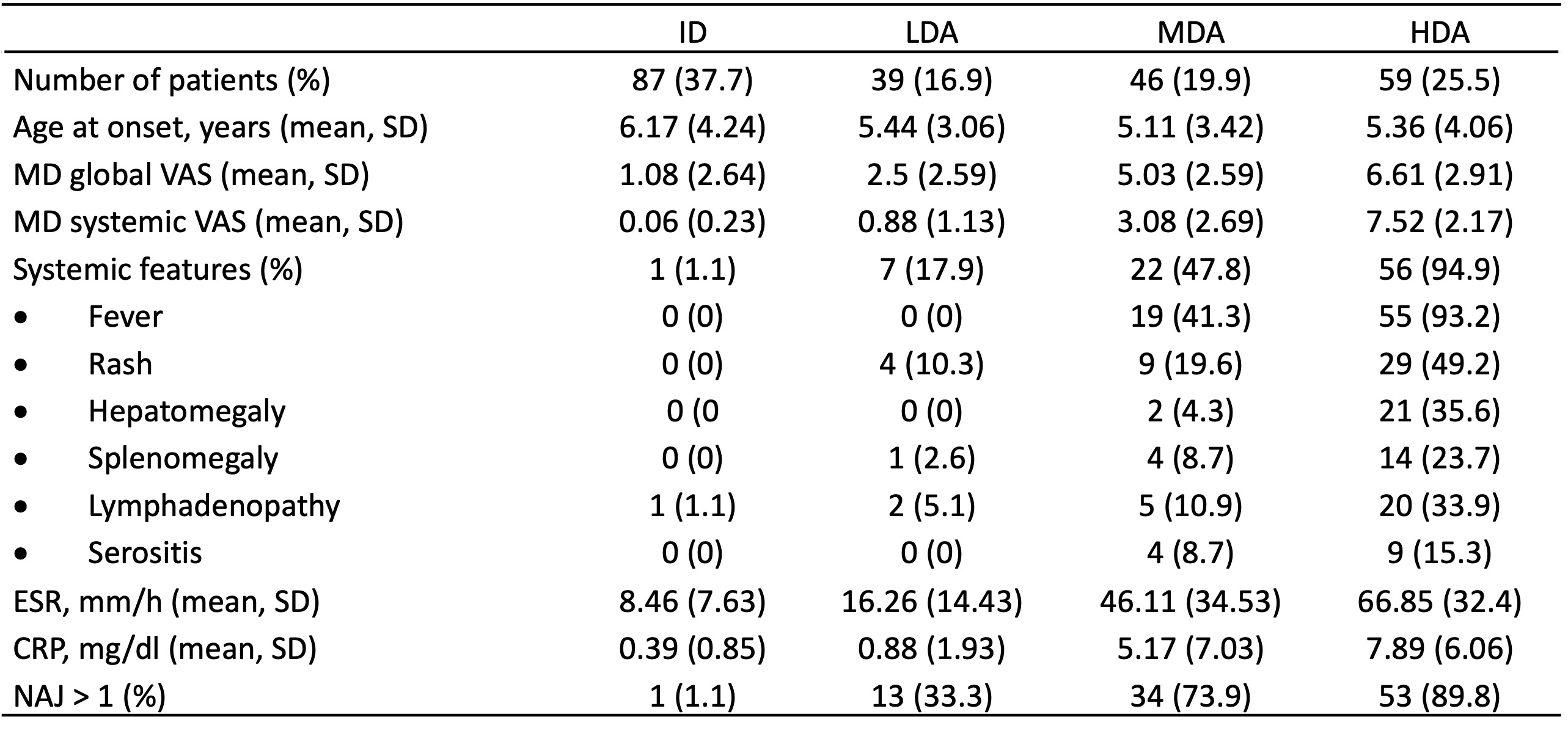Session Information
Date: Friday, March 31, 2023
Title: Poster Breakout 6 - Systemic JIA: Genomics, Transcriptomics & Disease States
Session Type: Breakout Session
Session Time: 4:30PM-5:00PM
Background/Purpose: Systemic juvenile idiopathic arthritis (sJIA) accounts up to 15% of all patients with JIA and is distinctfrom the other disease categories due to the association of articular and extra-articular manifestations. The systemic Juvenile Arthritis Disease Activity Score (sJADAS) is a composite disease activity score validated specifically for use in sJIA that includes, beside the 4 components of the original JADAS [Tibaldi J, Pistorio A, Aldera E, et al. Development and initial validation of a composite disease activity score for systemic juvenile idiopathic arthritis. Rheumatology (Oxford). 2020;59(11):3505-3514], a fifth item aimed to quantify the burden of systemic features. The interpretation of scores of sJADAS requires criteria that identify the states of disease activity. These criteria can be used to monitor the disease course over time and to define therapeutic targets. Our purpose was to compare the clinical and laboratory data of each disease activity state in patients enrolled in the multinational study aimed to define the sJADAS cutoffs.
Methods: Data were extracted from a multinational cross-sectional dataset that included patients diagnosed with sJIA by ILAR criteria, recruited between February 2022 and November 2022. At study visit, each patient was categorized subjectively by the caring physician into one of the following disease activity states: inactive disease (ID), low (or minimal) disease activity (LDA), moderate disease activity (MDA), or high disease activity (HDA). Study data was collected through a standard case report form and entered into an electronic database.
Results: A total of 231 patients were enrolled in 29 centers in 12 countries. The mean age at diagnosis was 5.63 years. 87 patients (37.7%) were judged as having ID, 39 (16.9%) LDA, 46 (19.9%) MDA and 59 (25.5%) HDA. The comparison of the main clinical and laboratory features across patients with the 4 disease activity states is shown in the Table. Overall, the presence of extra-articular manifestations was more common in patients with MDA and HDA (p 0.00001), whereas fever, rash, hepatosplenomegaly, and lymphadenopathy were more frequent in HDA patients (p 0.00001). The count of active joints increased progressively from ID to HDA (p 0.00001). The mean values of physician global assessment of disease activity and systemic manifestations, as well as the mean values of acute phase reactants, were highest in patients with HDA, with gradual decrease from MDA to LDA to ID.
Conclusion: This preliminary analysis of the study data indicates that the subjective assessment of disease state by the caring physicians led to discriminate reliably patients with different level of disease activity. This evaluation will, then, serve well as reference for the subsequent analyses aimed to identify the cutoffs for the main disease activity states in sJIA using the sJADAS.
 Comparison of clinical and laboratory features across disease activity states (n = 231). MD global VAS=physician global assessment of disease activity; MD systemic VAS= physician global assessment of systemic disease activity; ESR= erythrocyte sedimentation rate; CRP= C-reactive protein; NAJ=Number of active joints; ID=inactive disease; LDA= low (or minimal) disease activity; MDA=moderate disease activity; HDA=high disease activity.
Comparison of clinical and laboratory features across disease activity states (n = 231). MD global VAS=physician global assessment of disease activity; MD systemic VAS= physician global assessment of systemic disease activity; ESR= erythrocyte sedimentation rate; CRP= C-reactive protein; NAJ=Number of active joints; ID=inactive disease; LDA= low (or minimal) disease activity; MDA=moderate disease activity; HDA=high disease activity.
To cite this abstract in AMA style:
Rebollo-Giménez A, Vyzhga Y, Carlini L, Rosina S, Patrone E, Katsikas M, Magalhaes C, El-Ghoneimy D, El Miedany Y, Khubchandani R, Pal P, Simonini G, Filocamo G, Gattinara M, De Benedetti F, Montin D, Civino A, Alsuweiti M, Stanevicha V, Chasnyk V, Alexeeva E, Al-Mayouf S, Vilaiyuk S, Ravelli A. Towards the Definition of Cutoff Values for Disease Activity States in Systemic JIA Using the Systemic Juvenile Arthritis Disease Activity Score [abstract]. Arthritis Rheumatol. 2023; 75 (suppl 4). https://acrabstracts.org/abstract/towards-the-definition-of-cutoff-values-for-disease-activity-states-in-systemic-jia-using-the-systemic-juvenile-arthritis-disease-activity-score/. Accessed .« Back to 2023 Pediatric Rheumatology Symposium
ACR Meeting Abstracts - https://acrabstracts.org/abstract/towards-the-definition-of-cutoff-values-for-disease-activity-states-in-systemic-jia-using-the-systemic-juvenile-arthritis-disease-activity-score/
